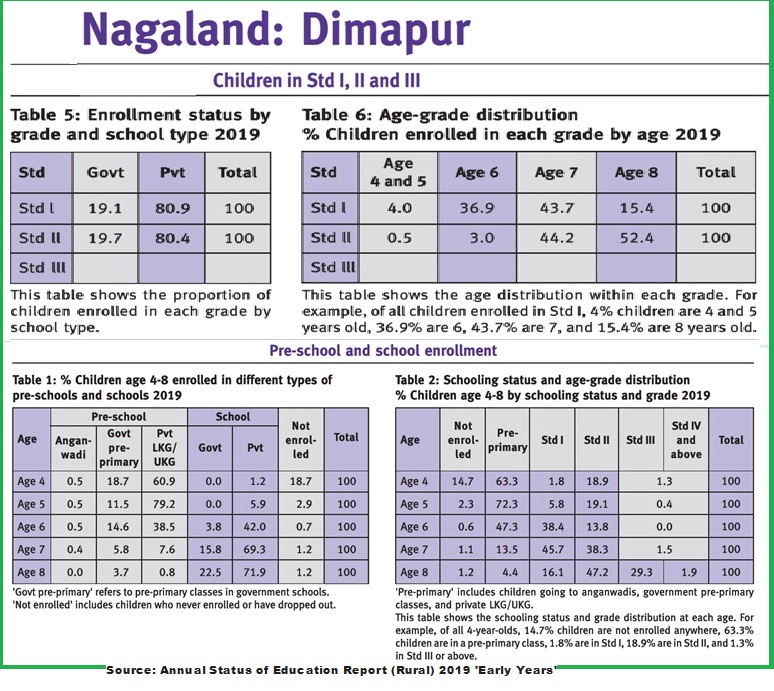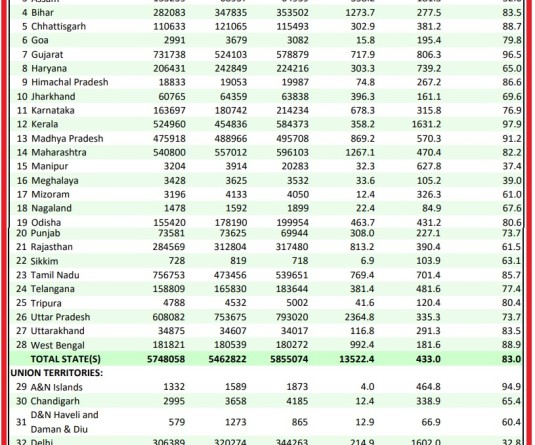Most parents prefer private over govt schools: ASER Report for Nagaland

Children in Std I, II &III as well as Pre-school and School enrolment in Dimapur Nagaland (Source: Annual Status of Education Report (Rural) 2019 'Early Years')
Over 80% children between 4-8 in private schools in Dimapur
Morung Express News
Dimapur | January 14
Only 19.1% of Standard (Std) I students were enrolled in government schools in Dimapur as in 2019 while the rest of 80.9% are in private schools. Similarly, only 19.7% of Std II students were enrolled in government run schools while 80.4% were studying in private schools.
This wide gap in the proportion of students enrolled in Std I & II between private and government run schools in Dimapur and that parents prefer private schools over the latter was highlighted in the latest Pratham’s Annual Status of Education Report (ASER) 2019 which was released today.
According to the report, ASER 2019 'Early Years' was conducted in Dimapur in Nagaland. The survey reached a total of 56 villages, 995 households, and 1,172 children in the age group 4 to 8. The outcome might also be verifiable in other districts as this is the general trend.
Sampled children's pre-school and school enrollment status was recorded. Children did a variety of cognitive, early language, and early numeracy tasks. Activities to assess children's social and emotional development were also undertaken. All tasks were done one-on-one with children in their homes.
In age grade distribution, the report highlighted that of all children enrolled in Std I, 4% children are 4 & 5 years old, 36.9% are 6, 43.7% are 7 and 15.5% are 8 years old. In Std II, 0.5% are 4 & 5 years old, 3% are 6 years old, 44.2% are 7 years old and 52.4% are eight years old.
Cognitive & other abilities
On the percentage of children who can correctly do cognitive and early language task by grade, the report said in Std I, 78.4% could do a seriation task, 74.7% could do a pattern recognition task, 84.5% could do puzzle, and 33.3% could listen, comprehend. In Std II, 87.6% could do satiation task, 77.6% could do pattern recognition task, 89.3% could do puzzle, and 36.2% could do listening and comprehension.
In distribution of reading ability among children in Std I, 4.6% could not even read letters, 29.9% could read letters but not words or higher, 43.3% could read words but not a Std level I text or higher, and 22.2% could read a std I level text and more.
In Std II, 0.5% could not even read letters, 16.2% could read letters but not words or higher, 30.9%, could read words but not a Std level I text or higher 52.3% could read a Std I level text and more.
On distribution of children’s ability to recognize numbers within grade, the report stated that among children in Std I, 0.9% children could not even recognize numbers up to 9; 8.9% children could recognize numbers up to 9 but could not recognize numbers up to 99 while 90.1% could recognize numbers up to 99.
In Std II, all children could recognize numbers up to 9; 7% children could recognize numbers up to 9 but could not recognize numbers up to 99 and 93% could recognize numbers up to 99.
On the percentage of children who could correctly do 1-digit and 2-digit numeracy tasks by grade, the report highlighted that in Std I, 54.9% children could do 1-digit oral word addition problem, 56% could do oral word subtraction, 85.4% could do a 1-digit relative comprehension task, 69.8% could do numeric addition, 60.7% could do numeric subtraction, 64.1% could do relative comparison. In Std II, 73.8% children could do 1-digit oral word addition problem, 65.7% could do oral word subtraction problem, 91.2% could do a 1-digit relative comprehension task, 87.6% could do numeric addition, 80.6% could do numeric subtraction, 73.8% could do relative comparison, 37.65 could do numeric addition and 24.4% could do numeric subtraction.
The report was conducted in 26 districts across 24 states in India, covering a total of 1,514 villages, 30,425 households, and 36,930 children in the age group 4 to 8.




